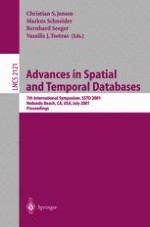2001 | OriginalPaper | Buchkapitel
On Multi-Way Spatial Joins with Direction Predicates
verfasst von : Hongjun Zhu, Jianwen Su, Oscar H. Ibarra
Erschienen in: Advances in Spatial and Temporal Databases
Verlag: Springer Berlin Heidelberg
Enthalten in: Professional Book Archive
Aktivieren Sie unsere intelligente Suche, um passende Fachinhalte oder Patente zu finden.
Wählen Sie Textabschnitte aus um mit Künstlicher Intelligenz passenden Patente zu finden. powered by
Markieren Sie Textabschnitte, um KI-gestützt weitere passende Inhalte zu finden. powered by
Spatial joins are fundamental in spatial databases. Over the last decade, the primary focus of research has been on joins with the predicate “region intersection.” In modern database applications involving geospatial data such as GIS, efficient evaluation of joins with other spatial predicates is yet to be fully explored. In addition, most existing join algorithms were developed for two-way joins. Traditionally, a multi-way join is treated as a sequence of two-way joins. The goal of this paper is to study evaluation of multi-way spatial joins with direction predicates: complexity bounds and efficient algorithms. We first give I/O efficient plane sweeping based algorithms for 2-way direction joins and show that by combining the plane sweeping technique with external priority search trees, a 2-way direction join of N-tuple relations can be evaluated in O(Nlogb N/M + k) I/Os in the worst case, where M is the size of the memory, b is the page size and k is the result size. The algorithms are then extended to perform a subclass of multi-way direction joins called “star joins”. We show that the I/O complexity of evaluating an way star join of N-tuple relations is O(mN logb MN +K + k), where mN2 is the size of the intermediate result, M, b and k (= Nm) are the same as above. We also apply the algorithm for star joins to evaluate a more general case of multi-way joins, which are star connections of star joins and show that this can be done in polynomial time. In the general case, we show that testing emptiness of a multi-way direction join is NP-complete. This lower bound holds even when in the join predicate (1) only one attribute for each relation is involved, and (2) each spatial attribute occurs a bounded number of times. It implies that join evaluation in these cases is NP-hard.
